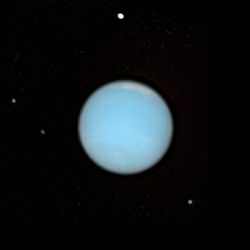

Blue-green Neptune and its satellites. Image credit: NASA/ESA Click to enlarge
New NASA Hubble Space Telescope images of the distant planet Neptune show a dynamic atmosphere and capture the fleeting orbits of its satellites. The images have been assembled into a time-lapse movie revealing the orbital motion of the satellites.
Images were taken in 14 different colored filters probing various altitudes in Neptune’s deep atmosphere so that scientists can study the haze and clouds in detail.
These are several snapshots from the Neptune movie.
The natural-color view of Neptune (to left), common to naked eye telescopic views by amateur astronomers, reveals a cyan colored planet. Methane gas in Neptune’s atmosphere absorbs most of the red sunlight hitting the planet, making it look blue-green. The image was created by combining images in red, green, and blue light.
Neptune’s subtle features are more visible in the enhanced-color view (top right). Images taken in special methane filters show details not visible to the human eye (bottom right). The features seen in this enhanced image must be above most of the sunlight-absorbing methane to be detectable through these special filters.
The planet is so dark at the methane wavelengths that long exposures can be taken, revealing some of Neptune’s smaller moons. Clockwise from the top (in composite image at left), these moons are Proteus (the brightest), Larissa, Despina, and Galatea. Neptune had 13 moons at last count.
Neptune is the most distant giant planet in our Solar System, orbiting the Sun every 165 years. It is so large tht nearly 60 Earths could fit inside it. A day on Neptune is between 14 hours and 19 hours. The inner two thirds of Neptune is composed of a mixture of molten rock, water, liquid ammonia and methane. The outer third is a mixture of heated gases comprised of hydrogen, helium, water and methane.
On April 29 and 30, 2005, Hubble images were taken every 4-5 hours, spaced at about a quarter of Neptune’s rotational period. These where combined to create a time-lapse movie of the dynamic planet.
Original Source: Hubble News Release
In 2007, astronomers discovered the Cosmic Horseshoe, a gravitationally lensed system of galaxies about five-and-a-half…
Venus differs from Earth in many ways including a lack of internal dynamo driving global…
The journey to Mars will subject astronauts to extended periods of exposure to radiation during…
Anthropogenic climate change is creating a vicious circle where rising temperatures are causing glaciers to…
Satellites often face a disappointing end: despite having fully working systems, they are often de-orbited…
Astronomers have known for some time that nearby supernovae have had a profound effect on…